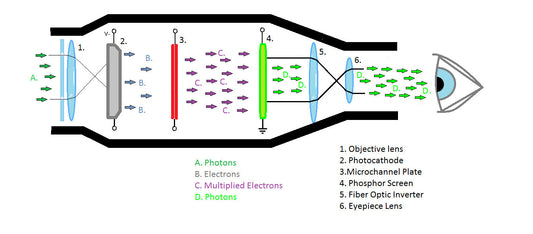From the moment when the Night Vision equipment was originally developed the devices of all generations are evaluated by two commonly used measures like Resolution and Light Gain. The Resolution, defined in lp/mm or line pairs per millimeter, measures how sharp and clear the amplified image will appear. The Light Gain measures how many times a night vision unit can amplify the available light.
The generation depends on what type of image intensifier tube is used for that particular device. In the technical specifications to describe the Generation is also used abbreviation "Gen".
Although you can think that Generation 1 was the first, there is also a Generation 0.
Gen.0 are a systems which use an anode in conjunction with the cathode to accelerate the electrons. These systems require use an active infrared projection unit attached to the Night Vision device. The IR Illuminator projects a beam of near infrared light which is similar to the beam of a normal flashlight but nvisible to the naked human's eye. The beam reflects off objects and bounces back to the lens of the Night Vision device.
There is a problem with this technology because enemy soldiers can use their own Night Vision devices to see the infrared beam projected by your device. As another major problems are image distortion and short tube life.
The first Night Vision devices Gen 0 are created by the United States Army and used in World War II and the Korean War.
Gen.1 is the next generation of Night Vision devices which can use passive infrared instead active infrared. This generation can use ambient light provided by the moon and stars to augment the normal amounts of reflected infrared in the environment.
That means that the devices do not require a source of projected infrared light but unfortunately they do not work very well on cloudy or moonless nights.
Gen 1 use the same image intensifier tube technology as Generation 0, so image distortion and short tube life are still the weakest points of these devices.
Low cost makes Gen 1 the most popular type of night vision in the world.
Gen.1+ is an improved version of Gen.1. Gen.1+ can surely compete with the Gen.2 in image sharpness and brightness but still has a resolution of Gen.1.
Often that is effect of successful application of digital technologies in observation optics. The technology employed in the device offers the option of a traditional black and white view when some light is available, and traditional green illumination for almost to completely dark conditions.
The image produced by Night Vision devices is typically monochrome. There is possible to use colours other than green, but the human eye can differentiate more shades of green than other phosphor colours.
Gen.2 ... to be continued.

